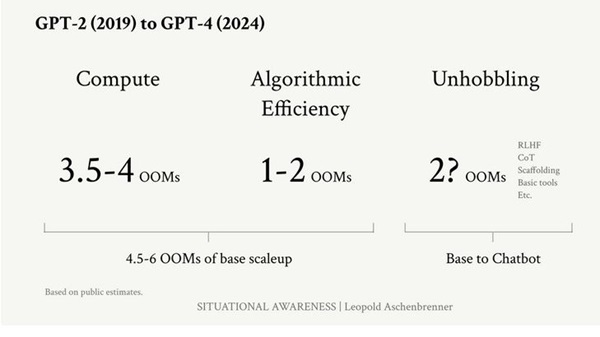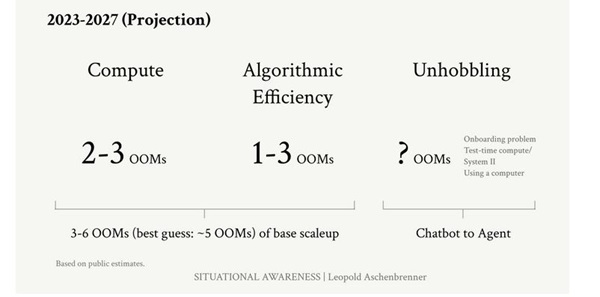AI: the irresistible rise
2 min
In his study “Situational Awareness: The Decade Ahead”, published this summer, Leopold Aschenbrenner outlined the developments to expect in the realm of artificial intelligence (AI). Enlightening, inspiring, but also alarming, here are the three key takeaways.
1. Beyond GPT-4: from kindergarten to advanced intelligence
Aschenbrenner highlights the remarkable leap in AI capabilities from GPT-2 to GPT-4, during which AI advanced from the intelligence level of a pre-schooler to that of an intelligent high school student. This progression has been driven by three critical factors:
- A dramatic increase in computational power – 3 to 4 orders of magnitude – what Aschenbrenner calls “OOM” (Orders of Magnitude).
- Enhanced algorithmic efficiency.
- Ingenious innovations like Reinforcement Learning from Human Feedback (RLHF).

Aschenbrenner predicts that the next leap – from GPT-4 to Artificial General Intelligence (AGI) – will follow a similar trajectory by 2027. AGI systems will be capable of learning and making decisions faster than human intelligence. Beyond increased computational power and better algorithms, AI engineers must find ways to enable robots to create and follow reasoning processes, aligning with Kahneman’s concept of “System 2” thinking.

2. AI PhDs and accelerated research
The second key point raised by Aschenbrenner is the exponential acceleration of AI itself. Once AI reaches the intelligence level of a PhD graduate, research in AI will undergo unprecedented growth.
Research that would typically take decades could be completed in mere months. This rapid progress could also lead to significant advancements in other complex fields, such as medicine and materials science. This acceleration stems from AI’s ability to independently generate, test, and refine hypotheses without human intervention.
3. The fear of dominance and the geopolitical nuclear equation
Finally, Aschenbrenner expresses deep concerns about AGI’s potential to disrupt the global balance of power. Just as nuclear weapons reshaped geopolitics in the last century, AI will play a decisive role in power struggles between nations.
He warns governments, particularly the US and China, against the temptation to weaponise AI for economic and military advantage. Aschenbrenner draws parallels with the nuclear arms race, where the first to develop superintelligent AI systems would gain a critical edge. This race could lead to political instability and economic dominance by technological superpowers.
Strikingly, Aschenbrenner advocates for AI research to be placed exclusively under governmental control. Will American or European leaders heed his call? The question remains open.
What is certain, however, is that the AI arms race is driving massive financial investment. Billions are being poured into infrastructure such as data centres and electricity, providing an economic boost. Yet, this surge could exacerbate inequalities, as AI benefits wealthier nations and tech giants more significantly. Simultaneously, AI will boost productivity while reshaping labour markets: some jobs will disappear, while new opportunities will emerge in digital sectors.
We are on the threshold of a transformative age.


